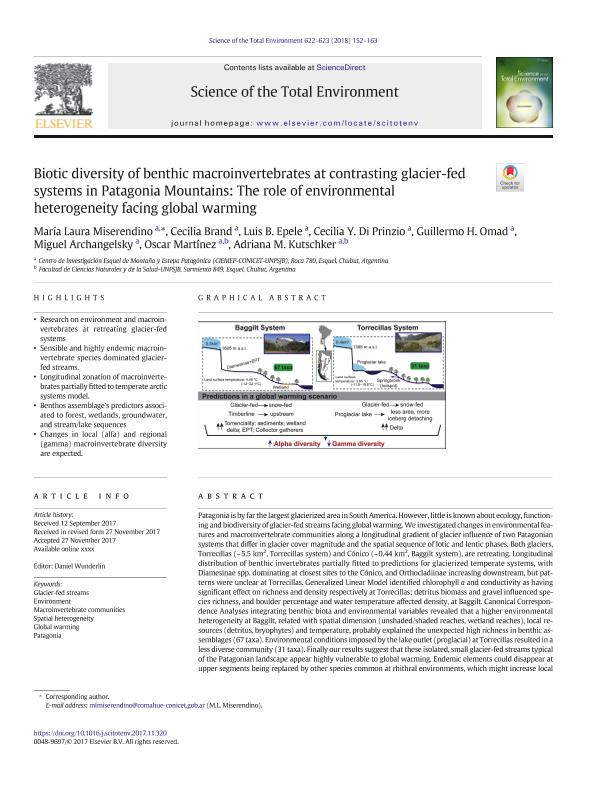Artículo
Biotic diversity of benthic macroinvertebrates at contrasting glacier-fed systems in Patagonia Mountains: The role of environmental heterogeneity facing global warming
Miserendino, Maria Laura ; Brand, Cecilia
; Brand, Cecilia ; Epele, Luis Beltran
; Epele, Luis Beltran ; Di Prinzio, Cecilia Yanina
; Di Prinzio, Cecilia Yanina ; Omad, Guillermo Hugo
; Omad, Guillermo Hugo ; Archangelsky, Miguel
; Archangelsky, Miguel ; Martínez, Oscar; Kutschker, Adriana Mabel
; Martínez, Oscar; Kutschker, Adriana Mabel
 ; Brand, Cecilia
; Brand, Cecilia ; Epele, Luis Beltran
; Epele, Luis Beltran ; Di Prinzio, Cecilia Yanina
; Di Prinzio, Cecilia Yanina ; Omad, Guillermo Hugo
; Omad, Guillermo Hugo ; Archangelsky, Miguel
; Archangelsky, Miguel ; Martínez, Oscar; Kutschker, Adriana Mabel
; Martínez, Oscar; Kutschker, Adriana Mabel
Fecha de publicación:
13/05/2018
Editorial:
Elsevier Science
Revista:
Science of the Total Environment
ISSN:
0048-9697
Idioma:
Inglés
Tipo de recurso:
Artículo publicado
Clasificación temática:
Resumen
Patagonia is by far the largest glacierized area in South America. However, little is known about ecology, functioning and biodiversity of glacier-fed streams facing global warming. We investigated changes in environmental features and macroinvertebrate communities along a longitudinal gradient of glacier influence of two Patagonian systems that differ in glacier cover magnitude and the spatial sequence of lotic and lentic phases. Both glaciers, Torrecillas (~ 5.5 km2, Torrecillas system) and Cónico (~ 0.44 km2, Baggilt system), are retreating. Longitudinal distribution of benthic invertebrates partially fitted to predictions for glacierized temperate systems, with Diamesinae spp. dominating at closest sites to the Cónico, and Orthocladiinae increasing downstream, but patterns were unclear at Torrecillas. Generalized Linear Model identified chlorophyll a and conductivity as having significant effect on richness and density respectively at Torrecillas; detritus biomass and gravel influenced species richness, and boulder percentage and water temperature affected density, at Baggilt. Canonical Correspondence Analyses integrating benthic biota and environmental variables revealed that a higher environmental heterogeneity at Baggilt, related with spatial dimension (unshaded/shaded reaches, wetland reaches), local resources (detritus, bryophytes) and temperature, probably explained the unexpected high richness in benthic assemblages (67 taxa). Environmental conditions imposed by the lake outlet (proglacial) at Torrecillas resulted in a less diverse community (31 taxa). Finally our results suggest that these isolated, small glacier-fed streams typical of the Patagonian landscape appear highly vulnerable to global warming. Endemic elements could disappear at upper segments being replaced by other species common at rhithral environments, which might increase local diversity (alfa diversity) but decrease regional diversity (gamma diversity). From an ecosystem perspective stream functioning can result altered. Glacier retreating or disappearing threatens major ecosystem services for Patagonian inhabitants such as water supply, hydrological regulation, recreation and tourism.
Archivos asociados
Licencia
Identificadores
Colecciones
Articulos(CIEMEP)
Articulos de CENTRO DE INVESTIGACION ESQUEL DE MONTAÑA Y ESTEPA PATAGONICA
Articulos de CENTRO DE INVESTIGACION ESQUEL DE MONTAÑA Y ESTEPA PATAGONICA
Citación
Miserendino, Maria Laura; Brand, Cecilia; Epele, Luis Beltran; Di Prinzio, Cecilia Yanina; Omad, Guillermo Hugo; et al.; Biotic diversity of benthic macroinvertebrates at contrasting glacier-fed systems in Patagonia Mountains: The role of environmental heterogeneity facing global warming; Elsevier Science; Science of the Total Environment; 622-623; 13-5-2018; 152-163
Compartir
Altmétricas



